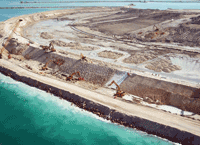
BASF working on Kuwait Sea City project
Dubai, February 23, 2012
German chemicals giant BASF said its construction unit is working with leading developer La'ala Al Kuwait on a groundbreaking architectural development coming up on a land that is mostly classified 'Sabkha' - a salt bog.
The Sabah Al-Ahmad Sea City Project is yet another awe-inspiring pioneering project in the region that has global environmentalists holding their breath as instead of reclaiming land back from the sea, it is bringing water inland to create ecologically- rich marine waterway city, said BASF Construction Chemicals which is helping to ensure its success.
Conmmenting on the project, Ian Williams, the project director at La'ala Al Kuwait said the city is a commercial and residential development that will, on completion, house over 100 000 people. "It is being built on land that was mostly classified 'Sabkha' - a salt bog," he added.
"As developers what we had proposed was to transform this land into a stainable, ecologically-rich environment by expanding the two existing intertidal creeks into inland lagoons, building self-sustaining islands on these waterways to create wildlife habitats, and planting mangrove to protect the new ecosystem," explained Williams.
"However, the biggest challenge was, to ensure sea tides could flush the system, oxygenating the water to ensure survival of the ecosystem and prevent pollution. This is where BASF came in," he said.
"The unique engineering solution the developer and designers came up with was a series of six massive tidally powered gates that allow for the tide circulation around the development," Williams noted.
"These gates were built into specially designed culverts which provide the main passage of the sea water to the lagoons. However, construction challenges presented themselves and this is where BASF expertise came into play," he added.
Williams pointed out that all six of the 10-ton 50 sq m culvert gates were supported by hinges fixed with 25mm Macalloy tension bars.
"To ensure these huge tensile loads were evenly distributed back to the concrete structure, a strong and durable non-shrink grout had to be used. BASF had an answer for us," he added.
"Durability was also a key factor given the extreme saline conditions of the local waters. In addition to the use of galvanized reinforcement, the developer, consultants and owners decided to coat the almost permanently submerged culverts with a protective membrane."
BASF Construction Chemical proposed the use a complete protection system from its range of advanced solutions, said Williams.
Dr Christian Geierhaas, marketing head of BASF Construction Chemicals said, "Masterflow 400 solvent free non-shrink epoxy resin grout was used to grout behind the gate hinges. This grout was chosen for its flowability and durability, and its ability to take on the dynamic loads which will be exerted by the Macalloy tension bars."
Masterseal SP 120 PF, a newly developed amine cured pitch free epoxy was used to coat the semi-submerged roofs, walls, and walkways of all the culverts to protect against chloride ion attack, he stated.
Dr Geierhaas said, "We are pleased that BASF was able to take part in the construction of the Sea City and be associated with the development. BASF is strongly driven by the philosophy of eco-friendly construction and we appreciate and fully support what they are trying to achieve," he added.-TradeArabia News Service







